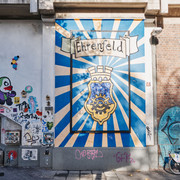Photos & Map
How would you like to arrive?
Details
Useful Information
Nearby
Cologne’s central cemetery
“Death is great, we are his…” wrote Rainer Maria Rilke, the lyric poet whose long, long, great prose poem Malte Laurids Brigge is considered a pioneering example of the modern novel. Death, the great equalizer, takes everyone sooner or later — but even while alive, people can obtain interesting impressions in cemeteries even if they are not directly affected.The Melatenfriedhof (Melaten Cemetery) is Cologne’s largest graveyard — and an old, fascinating central cemetery that tells art and social history as well as very private family stories.
Farina, Millowitsch, Bach, Riphahn, Westerwelle, Biolek and many other people
It is a park-like cemetery with more than 55,000 resting places in various architectural styles, from Neoclassicism to neo-Gothic, neo-Baroque, Art Nouveau, Art Deco and Modernism. Here rest many, many people — from times long ago and from the recent past.They all deserve to be commemorated — the people who are little known and the celebrities like Dirk Bach, Willi Herren or Willy Millowitsch, the Farina family, Hermann Götting, Wilhelm Riphahn or Alfred Biolek, to name just a few of Cologne’s notable residents. Other people who are buried here include Guido Westerwelle and Sophia Czory. The list of celebrities is long and goes back 200 years, which is why Melaten Cemetery is famous far beyond the borders of Cologne to people who like to take walks as well as to taphophiles and, of course, mourners.
Guided tours: prominent graves, tours, walks along the Avenue of Millions
Regular guided tours in the Melaten Cemetery unveil a place in the heart of Cologne where death, life and love come together with extraordinary flora and fauna to provide interesting and curious facts. Historical personalities, prominent graves, imposing monuments on the “Avenue of Millions” — guided tours through the historic, tranquil grounds are available in different versions for groups or individuals. The cemetery can be toured during the day, or even at night, by animal lovers who want to experience the more than forty species of birds and numerous species of insects, bats and squirrels in a special green space and landscape conservation area in the middle of Cologne.The Grim Reaper: The hallmark of the Melaten Cemetery
There are many historical monuments at Melaten Cemetery — after all, the graveyard, which was built on the site of a former leper colony on the model of Pere Lachaise and inaugurated in 1810, has been destroyed and restored several times throughout history. There are four war memorials, an old and new mourning hall, and many old expired grave sites preserved by sponsors.Perhaps one of the most visually striking statues is the Grim Reaper — the embodiment of death created by sculptor August Schmiemann for Johann Müllemeister: a tall figure with an hourglass and a scythe. Here lies Martin, the son of the patrons of the grave site, the Steinnus family. His tombstone in front is decorated with a frog.
The cemetery’s history: from illness to death...
From the 12th century, the Melaten farm belonged to a home for lepers. The asylum did not close until 1767, when leprosy was largely eradicated in Europe. When in 1804 a decree by Napoleon forbade burial within the city walls, the municipality bought a piece of the former asylum and demolished most of the buildings on it. On July 1, 1810, the first burial took place in the new cemetery, which was also planned from the outset to be a public green space and recreation area.Useful Information
Openings
General Information
Parking Available
Bus stop available
Eligibility
for Groups
for families
for individual guests
Payment methods
Entrance Free
Parking facilities
Bus line 142, Geisselstraße stop
Tram lines 1 and 7, Melaten stop
Tram lines 1 and 7, Melaten stop
Nearby









